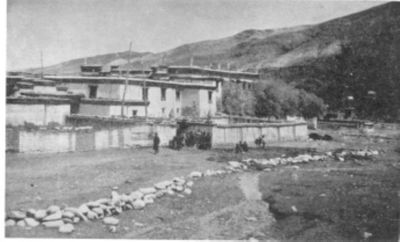Drolma Podrang: Difference between revisions
No edit summary |
No edit summary |
||
| (7 intermediate revisions by 4 users not shown) | |||
| Line 1: | Line 1: | ||
[[Image:Dolma podrang.jpg|thumb|400px|'''Drolma Podrang in Tibet]] | [[Image:Dolma podrang.jpg|thumb|400px|'''Drolma Podrang in Tibet]] | ||
'''Drolma Podrang''' ([[Wyl.]] ''sgrol ma pho brang'') — one of the two remaining branches of the [[Khön family]] lineage of the [[Sakya]] school. It was also the name for its physical residence (or palace, Tib. ''podrang'') in Tibet. | '''Drolma Podrang''' (Tib. སྒྲོལ་མ་ཕོ་བྲང་, [[Wyl.]] ''sgrol ma pho brang'') — one of the two remaining branches of the [[Khön family]] lineage of the [[Sakya]] school. It was also the name for its physical residence (or palace, Tib. ''podrang'') in Tibet. | ||
During the fourteenth century, Tishri Kunga Lodrö Gyaltsen (1299-1327), eldest grandson of [[Sakya Pandita]]'s brother, established four dynastic houses (Tib. ''lhabrang''): | During the fourteenth century, Tishri Kunga Lodrö Gyaltsen (1299-1327), eldest grandson of [[Sakya Pandita]]'s brother, established four dynastic houses (Tib. ''lhabrang''): | ||
*Shyithok (Wyl. ''bzhi thog''), | *Shyithok (བཞི་ཐོག, Wyl. ''bzhi thog''), | ||
*Rinchen Gang (Wyl. ''rin chen sgang''), | *Rinchen Gang (རིན་ཆེན་སྒང་, Wyl. ''rin chen sgang''), | ||
*Lhakhang (Wyl. ''lha khang''), and | *Lhakhang (ལྷ་ཁང་, Wyl. ''lha khang''), and | ||
*Düchö (Wyl. ''dus mchod''). | *Düchö (དུས་མཆོད་, Wyl. ''dus mchod''). | ||
Only the | Only the Düchö Labrang remains to this day. During the eighteenth century, the Düchö Labrang was split into two 'cousin' palaces, by 32nd [[throneholders of the Sakya school|Sakya Trizin]] [[Wangdü Nyingpo]], known as the: | ||
*Drolma Podrang and | *Drolma Podrang and | ||
*[[Phuntsok Podrang]]. | *[[Phuntsok Podrang]]. | ||
The Drolma Podrang was established by Sakya Trizin Jamgön Wangdü Nyingpo's eldest son, Pema | The Drolma Podrang was established by Sakya Trizin Jamgön Wangdü Nyingpo's eldest son, [[Pema Düdul Wangchuk]], while the Phunstok Podrang was established by his youngest son, [[Kunga Rinchen]]. | ||
The leadership in the Khön Family and the [[throneholders of the Sakya school]] have since then alternated between the Drolma and Phuntsok Podrangs. | The leadership in the Khön Family and the [[throneholders of the Sakya school]] have since then alternated between the Drolma and Phuntsok Podrangs. | ||
H.H. [[ | H.H. the 41st Sakya Trizin, [[Kyabgon Gongma Trichen Rinpoche]], is the current head of the Drolma Podrang at Rajpur, India, and his son, [[Khöndung Gyana Vajra Rinpoche]], is the current throneholder of the Sakya school. | ||
[[Category: Sakya]] | [[Category: Sakya]] | ||
Latest revision as of 15:02, 8 November 2022

Drolma Podrang (Tib. སྒྲོལ་མ་ཕོ་བྲང་, Wyl. sgrol ma pho brang) — one of the two remaining branches of the Khön family lineage of the Sakya school. It was also the name for its physical residence (or palace, Tib. podrang) in Tibet.
During the fourteenth century, Tishri Kunga Lodrö Gyaltsen (1299-1327), eldest grandson of Sakya Pandita's brother, established four dynastic houses (Tib. lhabrang):
- Shyithok (བཞི་ཐོག, Wyl. bzhi thog),
- Rinchen Gang (རིན་ཆེན་སྒང་, Wyl. rin chen sgang),
- Lhakhang (ལྷ་ཁང་, Wyl. lha khang), and
- Düchö (དུས་མཆོད་, Wyl. dus mchod).
Only the Düchö Labrang remains to this day. During the eighteenth century, the Düchö Labrang was split into two 'cousin' palaces, by 32nd Sakya Trizin Wangdü Nyingpo, known as the:
- Drolma Podrang and
- Phuntsok Podrang.
The Drolma Podrang was established by Sakya Trizin Jamgön Wangdü Nyingpo's eldest son, Pema Düdul Wangchuk, while the Phunstok Podrang was established by his youngest son, Kunga Rinchen.
The leadership in the Khön Family and the throneholders of the Sakya school have since then alternated between the Drolma and Phuntsok Podrangs.
H.H. the 41st Sakya Trizin, Kyabgon Gongma Trichen Rinpoche, is the current head of the Drolma Podrang at Rajpur, India, and his son, Khöndung Gyana Vajra Rinpoche, is the current throneholder of the Sakya school.